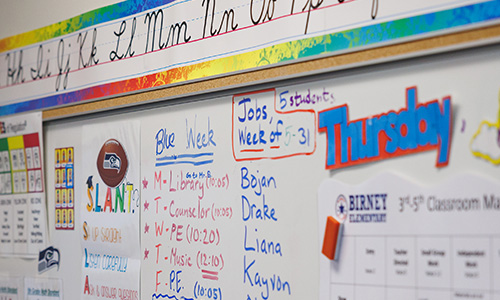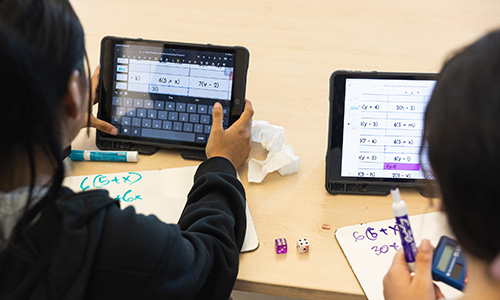
Teacher and student agency are critical for learning.
I remember when my parents started letting me order for myself off a menu. I was probably six years old, and I requested a cheeseburger (very sophisticated, I know). I can easily recall the sense of pride and maturity I felt as I sat up straight and prepared myself. Since then, it’s been a smorgasbord of sushi, chicken wings, and, as a native New Yorker, pizza of course.
Such a small shift—and a bit of ownership—completely changed my relationship to dining and food. I went from being told what to eat to being able to use my new favorite skill, literacy, to actually make a decision! The world was my oyster…even if oysters didn’t show up on my plate for a few more years.
Now that I’ve whet your appetite (I promise I’ll stop soon), think about the shifts we see in our students the moment we give them an option, a decision, a stake in their learning. Student agency, in all its forms, is a vital component of differentiation: that habitual, evergreen best educational practice. It’s no surprise that the more our students feel they are a key member of the learning team, the more engaged they are in the learning.
Taking into consideration who our learners are, and their specific context, helps us find opportunities for agency that empower the students and naturally push progress forward. But this doesn’t happen by accident.
School leadership that empowers and promotes inspired teaching
All quips about the struggles of adulting aside, it feels good to be able to make decisions. Especially when those decisions are made from a foundation of support and preparation.
Teacher and student agency go hand in hand. For teachers and, subsequently, students to flourish in their own agency, school leaders must provide the conditions for the reflection, growth, and courage needed to take ownership of learning. I think of my good friend Kim Borszewski, or Dr. B, the superintendent of Schiller Park District 81 outside of Chicago. We speak often of the conditions needed to empower educators, and they always come down to a few key tenets: having trust, feeling supported, and being well-informed before choosing a path. Encouraging teachers to seek out best-fit best practices for their personalities, or interests, shows them you not only value who they are as a teacher but also as an individual.
Once teachers feel they have the support of school administration to search out innovative classroom resources, the floodgates tend to open. When teachers feel they are trusted and seen as educational professionals, they can bring their best selves to the classroom. Speaking from experience as a math educator, I am grateful that my administration felt confident in my teaching abilities so I could bring my other skills and talents into the classroom. For example, my second degree in fine art, my love of music, and my creativity all had a place in a class that wasn’t necessarily fine art or music.
Does every initiative work? Will every option in agency be a success? No, of course not. But intentional planning and reflective redirection nurture the development of agency. Being able to try something new, without the fear of criticism or repercussions, creates the conditions for agency and creativity.
Clear for takeoff!
Once teachers feel their voice and choice matter, and make an impact, they have a clear runway to transfer and model agency to and for students. When a teacher’s confidence and comfort are apparent, it can be used as the model for students in their decision-making and self-advocacy. In fact, for math teachers in particular to model not only their problem-solving skills but also their process in choosing an avenue or a tool or resource, we show students the good habits we use within our agency. Why did I select graph paper and a ruler when other tools were available? Why did I choose to stand up at my desk rather than stay seated?
Of course, depending on the age group and content area, certain parameters should be in in place to keep the learning grounded and established learning goals at the forefront. Younger kids can be given a few options within an overall plan while making sure the learning goal is at the center of the activity; older students can have more flexibility and can be given more variety in their problem-solving.
Math should be a dynamic, exciting subject. Teachers should feel empowered to use their entire classrooms as an expansive learning space. Thinking back to Dr. B’s Schiller Park, the classrooms feel like customized workshops where clusters of desks for collaborative learning brush up against quiet nooks for independent think time. The learning isn’t centered in just one designated zone; it is happening everywhere! Students, within reason and when appropriate, have options for how and where they engage. Remember, more often than not, a bit of structure is needed. So teachers keep student agency and preference as a top priority when flexibly and purposefully grouping their students.
Small shifts for big impact
This kind of math classroom magic doesn’t happen overnight. To get to this level of agency, it takes small shifts in mindset, from the administration down, that are low risk but yield high rewards.
Reimagining school funds, teachers are encouraged to research practices, curricula, and resources and have the necessary green light from administration to advocate for their professional growth and best practices. That momentum, that confidence to have agency, can lead to small shifts in the classroom and enable students to show up authentically in their learning. Keep what is working and shift where possible. And put the power in the hands of your teachers and students.
Next steps for agency in the math classroom
A new school year is the perfect opportunity to start thinking about your triumphant return to the classroom. Here are a few easy steps to lead with agency before the last leaf falls:
- Be a differentiation expert. You may have read my post on my non-negotiables of highly effective differentiation. Being an expert in content, data, and your students creates the foundation to become a differentiation master. It also allows us to intentionally plan for student agency. Knowing where the bells and whistles lie within your upcoming unit, or opportunities for students to take a little learning journey, will help you better plan for those opportunities. Understanding your data, as well as your personalities, helps to inform how much or how little agency is offered.
- Show up as your authentic self. Think who you are has no place in the stoic, sterile world of the math classroom? Think again, my friend. With a nod from leadership, bring who you are to the classroom. Students benefit from seeing teachers in all their colors, and modeling agency and decision-making will give them the confidence to advocate for the learning style that best suits their unique personalities.
- Reflect on areas where small shifts are possible. Go back to the drawing board often, and revisit points in your lessons or unit where the math might have been lost or muddied. What can you do differently next time?
- Keep the learning goal at the center of the lesson and use agency to enhance it. Encourage yourself to keep coming back to your learning goals and exploring ways to give students enough agency to sustain excitement over the material.
- Establish norms so student agency doesn’t become classroom chaos. If choice is all of a sudden a new thing, the novelty will override the intention behind it. Start small, keep expectations high, and be prepared with a more narrow focus at first.






